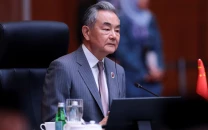Nepra approves Rs3.28/unit hike
New quarterly adjustments will add burden of Rs135.5 billion on consumers

The National Electric Power Regulatory Authority (Nepra) has granted approval for an increase in electricity rates of up to Rs3.28 per unit, leading to an additional burden of Rs135.5 billion on power consumers. This increase comes as part of the quarterly adjustments.
Until now, consumers were paying an additional Rs1.25 per unit due to ongoing quarterly adjustments, set to conclude this September. Out of the total increase, the new Rs1.25 per unit will remain, while an additional Rs2.03 per unit will be imposed for the next six months.
The power regulator announced this decision on Friday, citing a positive adjustment of Rs135,584 million. This increase is attributed to variations in capacity charges, Variable O&M, additional recovery on incremental sales, use of system charges, Market Operator Fee, and the FCA impact on T&D losses for the fourth quarter of FY2022-23.
Originally, the Ministry of Energy had filed a petition to raise power tariffs by Rs5.40 per unit, recoverable from consumers over three months. However, in an effort to prevent political backlash and consumer protests, the power division of the energy ministry requested the regulator to allow an increase of Rs3.55 per unit, spread over six months.
In response to the power division’s request, Nepra has granted permission for positive quarterly adjustments of Rs135,584 million, applicable to the fourth quarter of FY 2022-23. These charges will be recovered from the consumers of XWDISCOs (ex-WAPDA Distribution Companies) between October 2023 and March 2024.
Additionally, the power regulator has suggested that the government may consider maintaining a uniform consumer-end tariff for K-Electric (KE) and state-owned distribution companies, even after privatisation. This can be achieved through the incorporation of direct or indirect subsidies. Nepra’s policy guidelines mandate that it determines the application of quarterly tariff determinations of XWDISCOs on KE consumers through tariff rationalisation, in accordance with the same schedule and terms applied to XWDISCOs consumers. This policy will remain in effect for the same period, aligning with the financial sustainability of the sector and the uniform tariff policy of the federal government.
Therefore, KE consumers will be charged at a rate of Rs3.2814 per kWh, recoverable over the same six-month period from October 2023 to March 2024. Importantly, no quarterly adjustments will be passed on to Bl, B2, B3, and B4 industrial consumers to the extent of incremental sales, in accordance with a prior decision by Nepra dated 01.12.2020.
Tariff rise impacts residential, commercial consumers
The increase in electricity tariffs will have varying impacts on different categories of consumers. For households with a sanctioned load of less than 5kW, several significant changes have been introduced. The “Life Line” category, which applies to those using up to 50 or 51-100 units, will remain unchanged.
However, for households consuming between 1-100 and 101-200 units, there will be a tariff increase of Rs3.2814 per unit. This rate will continue for households consuming 201-700 units, while those using more than 700 units will face an additional charge of Rs3.2814 per unit.
In the case of commercial consumers with a sanctioned load of less than 5kW, they will encounter a uniform rate increase of Rs3.2814 per unit. For commercial consumers with a sanctioned load of 5kW and above, the same rate will apply, along with the introduction of a Time of Use (TOU) category for peak and off-peak consumption, also set at Rs3.2814 per kWh. Electric Vehicle Charging Stations will be billed at the same rate.
The tariff increase will also extend to residential colonies connected to industrial premises. Street lighting, as well as bulk supply categories at both 400 Volts and 11 kV, will also incur the same additional rate.
Nepra’s decision followed a public hearing held in late August to consider petitions regarding the hike in electricity rates. During the hearing, it was revealed that the major recovery would come from capacity payments amounting to Rs145 billion, to be collected from consumers who had consistently paid their bills. These payments will be disbursed to power plants that remained idle and out of operation.
Power division officials at the public hearing argued that spreading the tariff increase over six months would result in a rise of Rs3.55 per unit, rather than Rs5.40 per unit, due to lower power consumption during the winter season. They believed that consumers would not be startled by their electricity bills, as they tend to be lower during the winter months. Consumers were already paying an additional Rs1.25 per unit due to the quarterly adjustment, set to end in September.
Published in The Express Tribune, September 23rd, 2023.
Like Business on Facebook, follow @TribuneBiz on Twitter to stay informed and join in the conversation.



















COMMENTS
Comments are moderated and generally will be posted if they are on-topic and not abusive.
For more information, please see our Comments FAQ